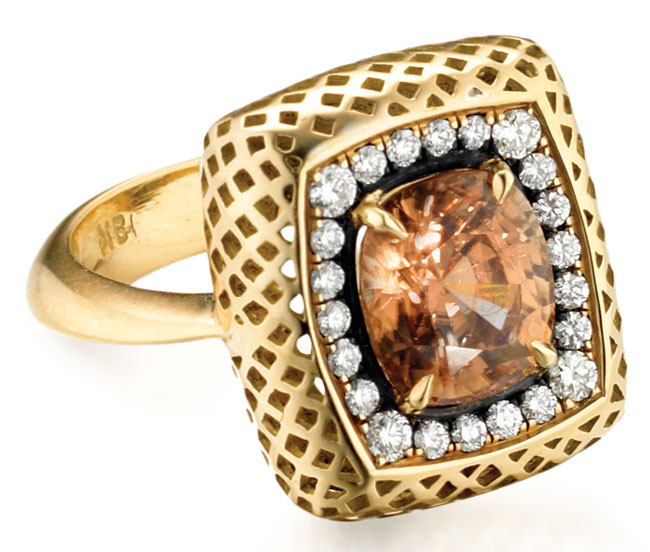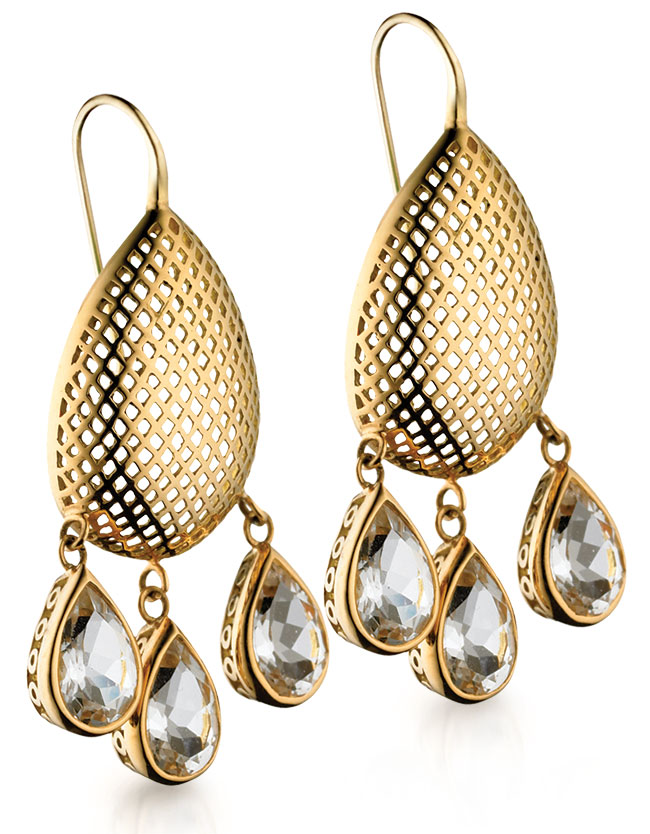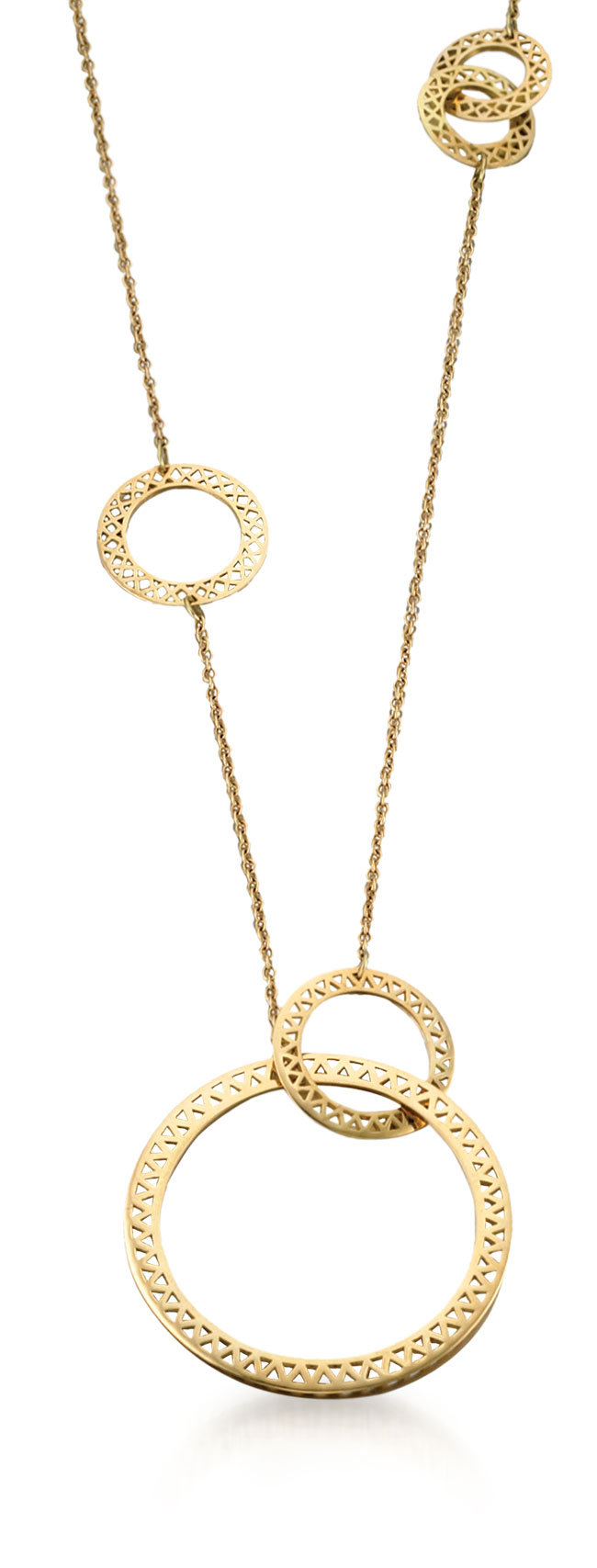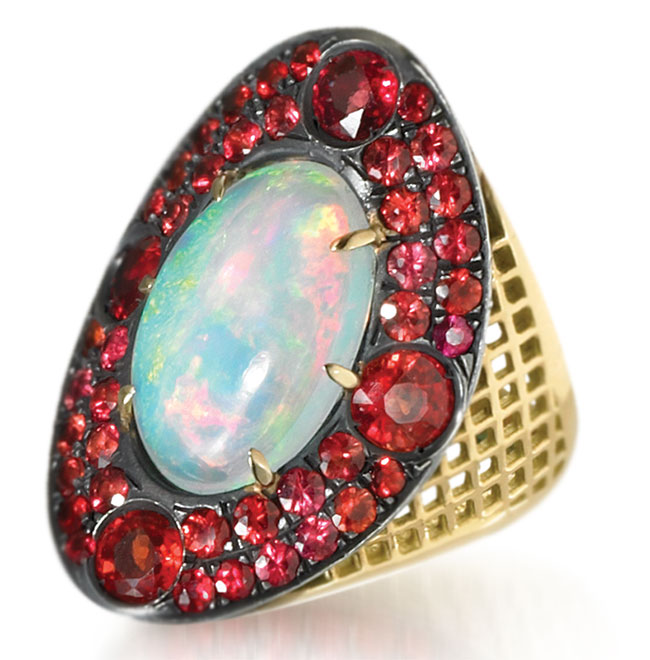RAY GRIFFITHS’ New York City studio, with its direct view of the Empire State Building, feels like a creative sanctuary at the top of the world. The career that brought him to that rarefied spot, however, began Down Under more than 40 years ago. His jewelry training started when he was a teenager. In his native Australia, he repaired the vintage treasures of some of Melbourne’s most venerable families. Today, he creates a new generation of heirlooms drawing on that early experience. His signature crownwork — a grid-shaped pattern that carries through all of his work — is a technique derived from antique jewelry construction. Insisting that he’s “better off being in demand rather than overproduced,” Griffiths eschews selling his jewelry in department stores in favor of working with independent boutiques exclusively, and wouldn’t dream of resorting to mass production. Along with one associate who’s worked with him since the very beginning of his business, Griffiths makes each piece that comes from his atelier in the sky.
Suite Memories
“One of my earliest memories of jewelry is of a suite of pieces that had been in the family for a few hundred years. My mother and her sister inherited it. When there was a big event like a family wedding, relatives would push them together to take a picture. The photo was of the jewelry, more than my mom and aunt. Early on, I understood that the intrinsic value of jewelry was important. That translates to why I make a quality product now. It’s my job to make something that people will enjoy in the future.”
Tough Break
“When I started my jewelry apprenticeship [at 15] I was handed a beautiful cabochon opal. I pinched it between my fingers, it fired out of my hand, dropped to the floor and broke in two. It belonged to a customer and was worth an absolute fortune. After that, I was terrified of opals. If anyone handed one to me, I would break out in a sweat. That was 43 years ago. I’ve only done a few opal pieces ever, starting about three years ago. I decided, ‘It’s time to let it go, Ray. Move on.’”
Welcome To New York
“With a partner, I had a small boutique in Sydney called Rox. I loved it and built a pretty groovy enterprise over nearly 20 years. But for ages I’d wanted to come to New York and figured I had one more go left in me. I packed everything I owned into a giant container and shipped it to New York, and I arrived in the city with two suitcases. After waiting and waiting for my container to arrive, I realized it had been stolen! I lost my entire life’s work … every photo … it was all gone in one fell swoop. I was totally busted.”
Forging Ahead
“I worked in a clothing store for a year to rebuild my wardrobe and buy jewelry equipment. Then, for 10 years I worked seven days a week: four days in my studio, and three at [jewelry boutique] Fragments. All along I knew wanted to go back to manufacturing — to have a little couture atelier. Someone once told me, ‘to be successful in New York, you have to fit into the market and create something nobody else can do.’ I was trained to do crownwork during my apprenticeship and I hadn’t seen it anywhere else. It’s a technique that takes the weight out of European headgear, like tiaras; otherwise it could be quite heavy. I decided to go historical … or hysterical, depending on how you see it.”
The One And Only
“I stick to crownwork because it is my signature, and I can interpret it in any style: It can suit 1950s Princess Grace of Monaco, or look old Egyptian or like a 14th century pontiff’s ring. Creating pieces that aren’t heavy is cost effective, too. You can sell luxury without being outrageously expensive. People say I don’t stamp my work, but I do. The crownwork is my stamp. It’s all trademarked. My work is unique, so I protect it. Could I do a whole different line that has nothing to do with crownwork? Yes. And I’m thinking about it.”
Everything Must Go
“Even if I don’t have a store anymore, I’m a real retailer. If it’s not bolted down, I’ll try to sell it. Once during an appearance at a store in New Orleans, the shoe department was busy and no one was looking at my jewelry, so I sold a woman three pairs of shoes! I couldn’t stand on the sidelines and not help. The reason I’m so focused on the quality of my jewelry is that I can feel good about selling it. It’s easy to be a good salesman when you’re selling a good product.”
Q&A: Getting Personal With Ray Griffiths
What’s your secret talent?
“I can shear a sheep with hand shears. I’m not as fast as I used to be, though.”
If you could time travel, where would you go?
“I’m very inspired by the British Regency period: the 1840s through 1850s. The world was modern then, so it wouldn’t be too hard to adjust.”
What’s the best advice you’ve ever received?
One word: Focus!
If you could try another career, what would it be?
“I’d be an architect. Architecture inspires me and the work I do now.”
What’s your dream travel destination?
“I really want to go to St. Petersburg and Lebanon. Beirut, even after so much destruction, is supposed to be incredible.”
The Work: Jewelry From Ray Griffiths

Crownwork cocktail ring with cushion-cut natural honey zircon (3.90 TCW) and pavé diamond surround (0.44 TCW) set in oxidized silver. MSRP: $5,490

Pear shape crownwork earrings in 18K yellow gold with triple white topaz drops. MSRP: $3,950

18K yellow gold 20-inch asymmetrical crownwork disc necklace. MSRP: $4,170

Crownwork shank shield ring in 18K yellow gold with opal, bezel-set ruby and orange sapphires set in oxidized silver. MSRP: $8,130